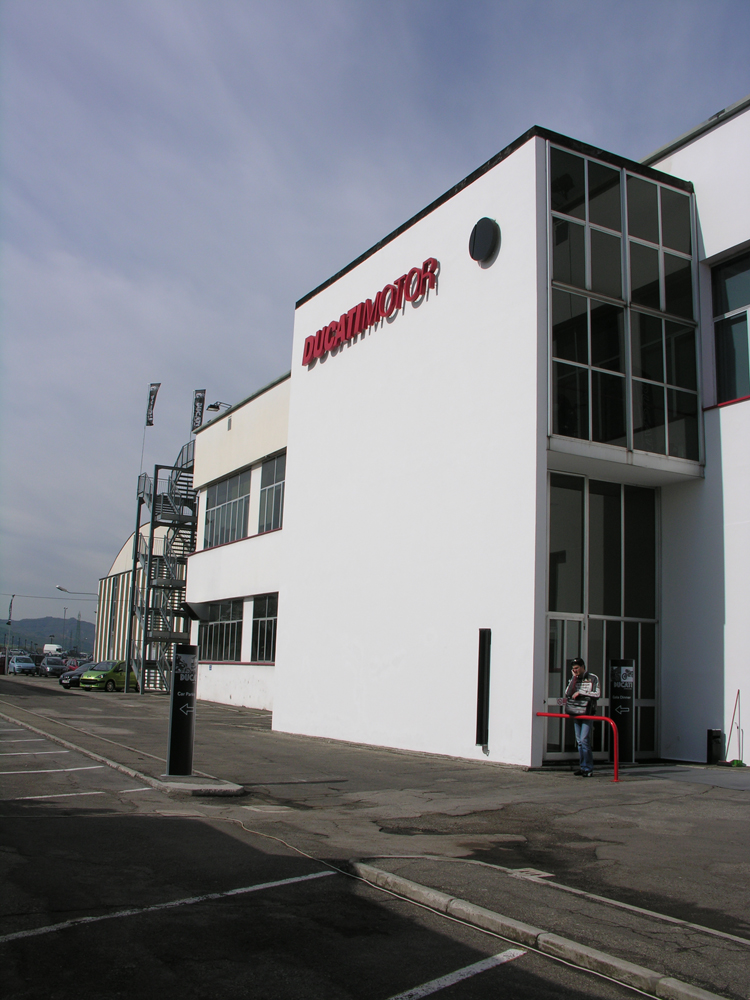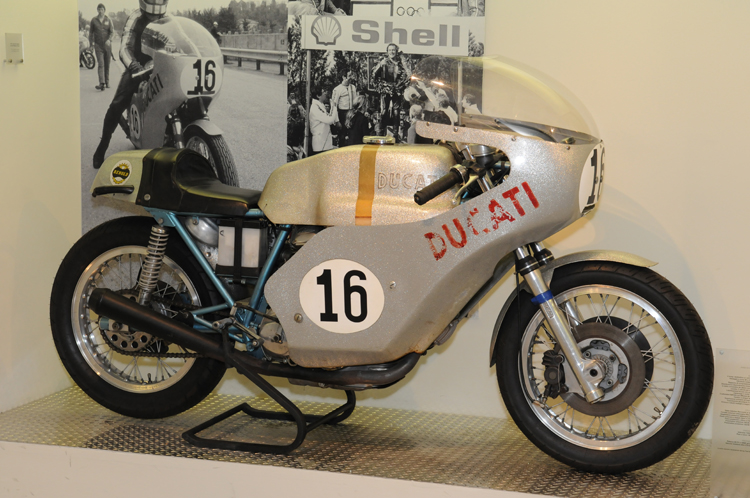Ducati Factory Italy

I was struck dumb with amazement, and when Lord Carnarvon, unable to stand the suspense any longer, inquired anxiously "Can you see anything?" it was all I could do to get out the words "Yes, wonderful things." *
I remember feeling the kind of excitement Howard Carter experienced on seeing the contents of Tutankhamen's tomb when I first visited the Ducati Museum at the company's factory in Borgo Panigale, Bologna.
That first museum tour had been taken as a guest of Ducati at the press introduction for the GT1000 Sport Classic. We'd been expected, of course, and we were shown every courtesy. My second visit was less exalted. I arrived with three companions and had no reservation.

"Can we see the museum, per favore?" I asked the security guard.
"'Ave-a you book-ed a tour?" We hadn't. "No possi-bull."
It turns out that every weekday as many as 200 visitors are guided around the Borgo Panigale factory in parties of 20 and allowed to spend 15 minutes drooling in the museum. Tours for the next few days were fully booked but, fortunately, my factory contact, International Press manager Massimo Davoli was able to squeeze us into a tour later that afternoon. So, make sure you book ahead if you're planning a visit.

The Museum…
The brainchild of former Ducati president Federico Minoli, the Ducati museum project got underway shortly after Ducati's takeover by Texas Pacific Group in 1996. The new owners were keen to capitalize on Ducati's racing heritage as a way of creating a strong identity for the company's products. Minoli hired Marco Montemaggi, who had helped in the creation of Ferrari's museum, to be the first curator.

No mere assemblage of dusty bikes parked in an industrial warehouse, the Ducati Museum is more art exhibition than motorcycling mausoleum, and perhaps a little credit is due New York's Guggenheim Museum for its layout. The bikes are arranged in more-or-less chronological order around a curved theater, its walls paneled with giant heritage posters, and panels in the floor illuminate each machine in a subdued light.
The representative milestones in Ducati's history on display are: the Cucciolo moped; Fabio Taglioni's 100cc "Marianna" race bike and 125cc Gran Sport; Bruno Spaggiari's 500cc Desmo twin; and a long line of Superbike championship bikes ridden to countless victories by Marco "Lucky" Lucchinelli, Doug Polen, Carl Fogarty and Troy Bayliss. Nearby, the Moto GP machines ridden so successfully by Loris Capirossi and Casey Stoner are arranged. If Italian racing red is your favorite color, there's plenty here!

One of the first bikes Montemaggi acquired was Paul Smart's 1972 Imola-winning 750SS. Paul freely donated the bike, which he had been allowed to keep as part of the deal that brought him to the Ducati team. And the acquisition of this bike proved pivotal in persuading other successful Ducati racers to part with their own bikes.
A series of more brightly lit rooms around the theatre feature other significant Ducatis: Mike Hailwood's "comeback" 1978 Isle of Man TT-winning 900SS; Edi Orioli's Dakar-winning 900 Elefant (a Cagiva with a Ducati motor), and the ill-fated Apollo.

Creation of the Apollo, Ducati's first multi-cylinder motorcycle and another Taglioni design, began when Ducati's US importer Joe Berliner requested a motorcycle he could sell to America's police forces. The result, a 1250cc 90-degree V-4, was perhaps 15 years ahead of its time, and at 100 hp and 600 lbs, it was much too heavy and powerful for the tires available at the time (1964). The only one that had survived was believed to be in Japan.
Locating and acquiring this Apollo prototype became the personal quest of the museum's current curator Livio Lodi. He tracked it down, and the Japanese owner agreed to loan it to the museum in exchange for its restoration.
"Finding it was like discovering the Titanic for me!" Lodi said when interviewed by Kevin Ash for his book Ducati People. "And finding it in 2001 was significant. This was the year depicted in the film 2001: A Space Odyssey - and finding this bike had been my own personal odyssey."
…and the Factory
Ducati has been at the same location in Borgo Panigale since 1935, though the company actually began a decade or so earlier. Antonio Cavlieri Ducati - like another more famous Bolognese, Guglielmo Marconi - was a pioneer of radio development and went into business manufacturing capacitors and other electronic components. His three sons, Marcello, Adriano and Bruno, took over the business, and, while diversifying into optical, photographic and household items, gave no thought to producing motorcycles.
After falling under Italian government control as part of the post-WWII Ricostruzione, the company started assembling engines made by Siata in Turin into bicycle frames to produce the Cucciolo moped. However, the original factory, badly damaged by allied bombing, had been abandoned, and a new factory was subsequently built on adjacent land.
Though steeped in tradition, the "new" Ducati factory makes the most of modern equipment such as CNC mills and lathes, and computer-controlled testing. But as do most modern motorcycle manufacturers, Ducati subcontracts their frame assemblies, castings and major components like forks, wheels and brakes as well as electronics and fuel systems. Finishing and assembly are then done in-house. So, the smoke and thunder of foundries and presses is absent. In fact, the factory seems clean enough for food production!
Manufacturing takes place in two stages: engines are assembled in one area of the factory, then loaded onto carts and brought to the main assembly line. At each station, a complete motorcycle is screwed and bolted together around the powertrain from a kit of parts put together for that particular model.
The most interesting part of the factory, though, must be the testing booth. Completed motorcycles are filled with oil and coolant and fitted with a temporary gas tank, then rolled on to a dynamometer. The engine is started and run through the gears pretty much at full throttle up to almost maximum speed before running back down to a "standstill" and then the process is repeated. So much for careful breaking in!
Instructive, too, is the area set aside for completed machines, each labeled with its destination country, before being boxed for shipment. There are Monsters for Germany, Multistradas for the US, Superbikes for Australia - one of Ducati´s most successful markets - and many more. The plethora of machines and markets simply hammers home how successful Ducati has become.
No museum would be complete without a gift shop, and the Ducati faithful can purchase official logo attire and memorabilia from a small store by the entrance. But if you have to have a bike to take home, there also is a convenient Ducati dealership just a block away.
* From The Discovery of the Tomb of Tutankhamen by Howard Carter and A. C. Mace.










